China 1368 to 1800
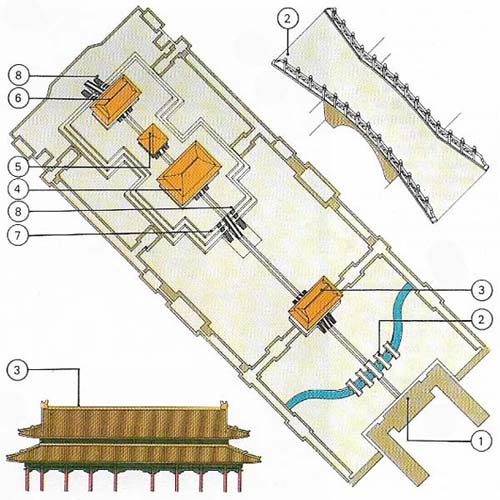
Figure 1. The Imperial Palace in Peking was the seat of 22 Ming, and Ch'ing emperors after Peking became the capital in 1421. Begun in 1406, the palace now covers 720,00 square meters (7,750,000 square feet). The palace is an assemblage of imperial buildings, the most important (shown here) containing the ceremonial halls. The principal entrance is through the Meridian gatehouse (1) leading to the Golden Water River with its five marble bridges (2). After the second gatehouse (3) lies the first great hall (4), which holds the imperial throne. The halls (5, 6) stand on the marble, three-tiered Dragon Pavement (7) with triple staircases (8).
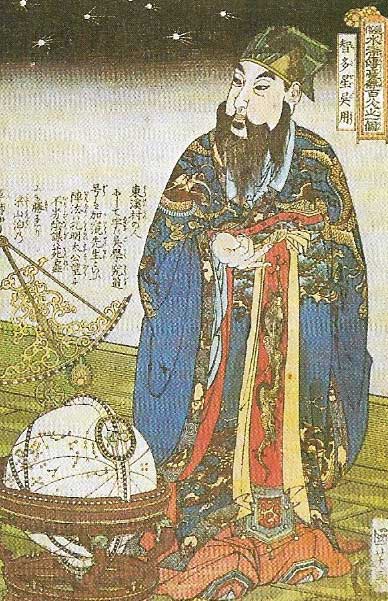
Figure 2. Chinese astronomers were the most persistent and accurate observers of celestial bodies anywhere before the Renaissance. The importance of the calendar for a primarily agrarian society and the state interest in astrology meant that astronomy was of central importance in their lives. In contrast with Europe, scientific work was not a private concern and astronomers often worked from the Imperial Observatory in Peking. Their observations, like the work of scientists in Amy other fields, were included in large encyclopaedias that were compiled and published at the instigation and sole expense of the state.
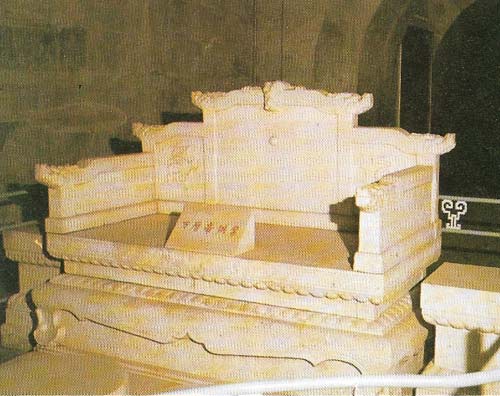
Figure 3. The throne of the Ming Wan-li emperor was placed in his tomb. Ming emperors generally enjoyed an unprecedented, although often abused, degree of power. Ultimately the Ming dynasty fell to the invading Manchus who seized Peking in 1644, but already during Wan-lei's reign internal dissent and foreign attacks threatened Ming power.
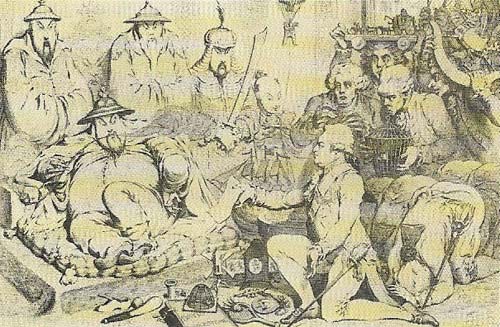
Figure 4. The first official British mission to China was made in 1792 by Lord Macartney (1737–1806) and came at a time of demands for increased trading rights as the British and other foreign powers pressed for a foothold, already the British East India Company had a monopoly over the trade in tea. However, the mission was treated by the Ch'ien-lung emperor as purely diplomatic.
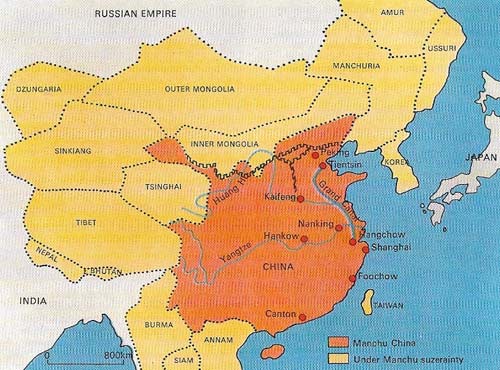
Figure 5. The Manchu Empire in 1800 covered a large area of central and South-East Asia. But already European and Russian expansion in search of trade threatened this shaky conglomerate.
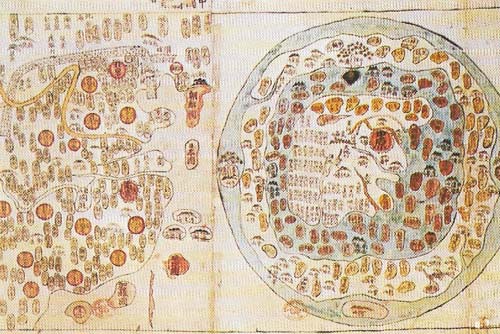
Figure 6. This Sinocentric map (c. 1800) shows China at the center of the world, both culturally and geographically, as a "Middle Kingdom" surrounded by barbarians. China was generally self-sufficient and pursued a policy of aggressive isolationism, believing that little was to be gained by contact with other peoples.
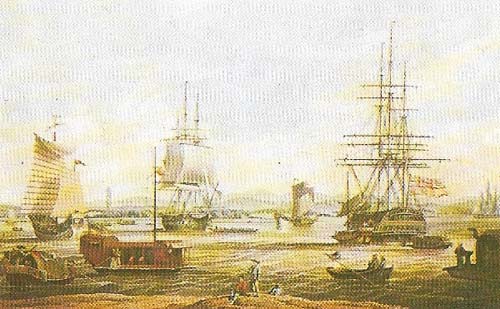
Figure 7. European ships moored in the port of Canton in the 18th century reflected the West's desire to trade with China. Western merchants regarded the China trade as an immensely rich prospect, but China refused to allow trading. From 1557 the Portuguese had had a monopoly of trade with China from Macao until the Dutch began to trade but attempts by the British East India Company in the early 17th century failed to gain official approval. The Europeans pressed for trading concessions, but from the 1750s all foreign trade had to go through Canton and was strictly supervised by the state. British trade in tea grew during the 18th century and in the 1780s they began to smuggle in opium profitably from India.
The Ming or "Brilliant" dynasty (1368–1644) was founded by a Buddhist peasant who became leader of the rebel bands that overthrew the Mongol rule. He made his capital at Nanking and gave himself the title Hung Wu (reigned 1368–1398). Under the new emperor the government reverted to the T'ang system of Confucianism, taxes were reduced and peasants were encouraged to work harder by being allowed to keep the land they reclaimed. The empire expanded, taking in vassal states which included Annam and Siam. Maritime expansion also occurred and under the able command of Admiral Cheng Ho fleets of exceptionally large Chinese vessels made seven expeditions between 1405 and 1433 to places as far away as Sri Lanka, the Persian Gulf and parts of Africa. The ships carried merchandise and Cheng Ho was able to establish trading relations with about 30 ports.
Protection of the homeland
At home the government was determined to defeat further invasions from the north. The Great Wall was repaired, many towns were fortified and Nanking was surrounded by a wall 32 kilometers (20 miles) long and 18 meters (60 feet) high. This "closed door" policy of the Ming was similar to that of the early Sung period, which had also established Chinese rule over the Middle Kingdom after a period that had witnessed foreign intervention. In spite of this attitude the Ming were to see the arrival of Europeans from the south. The Portuguese established a settlement in Macao and were followed by missionaries. The Ming built numerous palaces and splendid tombs, the most famous being the Imperial Palace in Peking (Figure 1) and the tombs of the emperors north of the city (Figure 3). In 1958 that of the Wan-li emperor was opened to reveal three lacquer coffins containing the bodies of the emperor and two of his wives.
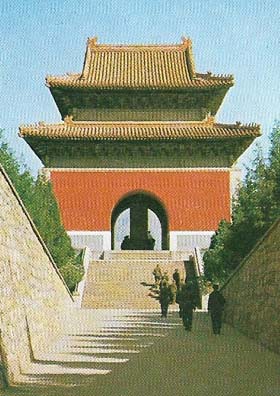 |
| The tomb of the Ming Wan-li emperor (1573–1620) is situated at the foot of rugged mountains to the northwest of Peking. The complex is approached by an avenue lined with impressive stone sculptures of guardian animals, soldiers and officials. Work on the tombs began in 1584 and took four years. |
The end of the Ming dynasty
In spite of all the elaborate precautions for security, the Brilliant dynasty reached its end when northern barbarians, in this case the Manchus, entered north China. They came at the request of the Ming commander who sought their help to unseat a rebel, Li Tzu-ch'eng, who had made himself master of Peking. Rather than submit to humiliation the last Ming emperor hanged himself and the rebel emperor in his turn was overthrown by the Manchus whose leader, Fu-lin (1638–1661), proclaimed himself emperor and set up the Ch'ing or "Pure" dynasty. For a century and a half the Manchus governed wisely; they provided the country with domestic prosperity and extended its boundaries beyond all previous limits. The emperors ruled as conquerors and skillfully protected themselves against rebellion by instituting a system of banners. These were military and administrative divisions in which the people were systematically registered, taxed and conscripted. The Manchus were unable either to read or write and accepted the Ming examination procedure for the selection of civil service officials. They were careful, however, to forbid the Chinese to hold office in their native provinces and they also divided responsibility in such a way that the officials were obliged to keep a check on one another. The Manchus were more sophisticated than the Mongols and proved to be neither barbarous nor destructive, but in fact grew to admire Chinese culture. One of their first acts was to request a group of scholars to write a history of the Ming dynasty which was followed by a vast encyclopedia, the Ssu-k'u ch'uan-shu, comprising 36,000 volumes, begun in 1772 and completed in 1781.
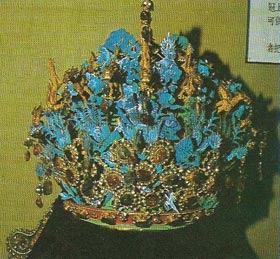 |
| This Ming imperial crown, decorated with a phoenix, is indicative of Ming wealth and their patronage of the arts. |
The influence of the Manchu
Abroad Manchu authority spread to Manchuria, Mongolia, Tibet, and Turkestan. During the Ch'ien Lung era their armies entered Burma, Nepal and Annam (Figure 5). As the empire grew in size and wealth foreigners increased their pressure to trade with this huge untapped territory. The Jesuits, who had been accepted during the Ming dynasty, were now followed by other Catholic orders from Europe and before the end of the 17th century Franciscans, Dominicans, Augustinians, and members of the Society of Foreign Missions in Paris had established themselves in several cities in the interior. European merchants did not penetrate China as readily as the missionaries, but they persisted in their efforts and eventually limited trading facilities became available for the French, British, Dutch and Portuguese. In 1784 the first of many ships from the United States arrived. By the middle of the 18th century British trade, the monopoly of the British East India Company, had outpaced all others (Figure 7). Chinese silk, tea, cotton and porcelain were in endless demand in Europe. However, business could be carried out only through selected groups of Chinese merchants, the Co-Hung. There were no fixed tariffs, a policy that increased corruption amongst officials. The Chinese were forbidden to teach the foreigners their language and foreigners had to submit to Chinese law in Chinese courts, where the Chinese with their belief in group responsibility held the foreign communities liable for the misdemeanor of any of their members. Such conditions soon became impossible. The Western trading countries therefore sent missions to Peking (Figure 4), which began the lengthy process of bringing China out of her diplomatic, cultural and economic isolation.
